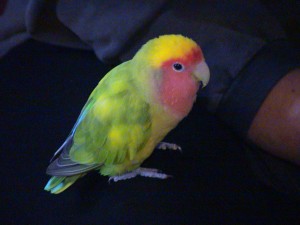
We first met Ariel in 1994, when he lived with some friends in the nearby hills. They had a small menagerie of birds: a parrot, a few African peach-faced lovebirds and some others. There was one lovebird who was especially attractive and affectionate: his name was Ariel.
At our first meeting, he came to RoZ’s shoulder and nibbled on her ear. “He seduced me,” she said later. She fell in love with this little bird, and said, “If you ever need a home for him, give us a call.”
Three years later we got that call. “We’re downsizing our menagerie.” Could we take Ariel? At the time we lived in a “no pets” apartment, but we were on good terms with the landlord, who said a bird would be OK “as long as he stays in his cage.” We must confess, we often broke that rule.
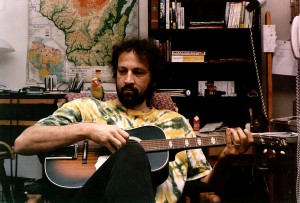
“Woodstock Ariel” encourages the musical arts in 1998.
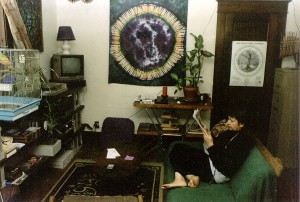
Ariel keeps an eye on the living room from his cage on the left.
His cage found a place on a shelf next to the TV in our living room window, but a couple of times a day we’d let him out for “exercise.” This exercise consisted of kicking the door open, climbing out the door and to the top of the cage, then flying over to one of our shoulders and hanging out there until it was time to “go home.”
He always seemed genuinely interested in whatever it was we were doing. Sometimes he would cuddle to Obbie’s beard, or he would let RoZ pet him like a dog. RoZ was the only person that Ariel ever allowed to touch him in this way.
As for “going home” when asked, Ariel was a two-year-old with wings, and would make us chase him around the house to catch him. We learned to extend our reach with a bamboo cane, and Ariel learned to understand the command “Go home!”
Ariel’s Antics
One night we rented the movie, “And Now for Something Completely Different,” a collection of the best stuff from Monty Python’s original TV series. During the famous “dead parrot” sketch, we were laughing hysterically when Ariel began to squawk angrily. Somehow he knew we were laughing at a dead parrot, and being a miniature parrot himself, he did not think this was funny at all. His disapproval made us feel bad, but we couldn’t help laughing even more, which added to his humiliation.
While Ariel’s call was very high-pitched, he was very sensitive to high-pitched sounds. Anything that whistled or hissed got his attention. He was also attracted to spraying water, both for the sound and the water. This led to a funny thing that happened in the shower one day.
Ariel liked to hang out on the curtain rail while we were showering, to shower himself in the misty spray that bounced off of our heads and shoulders. Sometimes he’d come down to our shoulders to get closer to the source of the misty spray. One day Obbie was rinsing his hair and Ariel came down to his shoulder. Obbie turned around to rinse the other side of his head. Normally, Ariel would maneuver around to maintain his position relative to the water, but this time his foot got tangled up in Obbie’s hair and he took a direct hit from the shower head.
Somehow he managed to get back to the curtain rail, but when he tried to fly off he fell to the floor like a rock. Obbie peeked thru the curtains, worried that Ariel might be hurt. What he saw was Ariel walking out from under a plant stand, drenched, disgusted and humiliated. He was transformed into a bizarre Dr. Seuss character, his saturated feathers pointing in every direction and his feet going “splat, splat, splat” as he stomped across the bathroom floor.
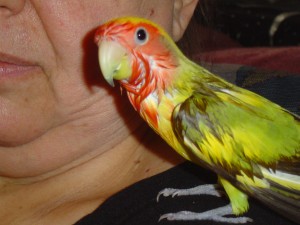
A very wet Ariel on RoZ’s shoulder
We never laughed so hard in our lives, which of course humiliated Ariel that much more. After that, Ariel was not as excited about joining us at the shower, and he never left the curtain rail again.
Leira
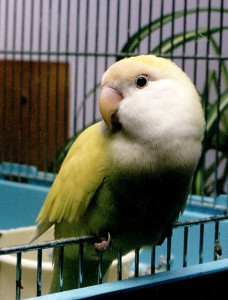
Leira, January 2000
Love birds like to come in pairs, so being a single guy, Ariel’s romantic desires were left unfulfilled. Back when he was a young stud, his time out of his cage was spent – not on our shoulders – but on our toes. If one wore the right socks and propped up shoeless feet, he would march down the leg, climb up onto the toe and start humping. We got to thinking, “we have to find him a girlfriend.”
The menagerie that Ariel came from underwent another downsizing, and we took in two more lovebirds. Ubu looked a lot like Ariel, except that he wasn’t as brightly colored. There was also an unnamed yellow bird. Neither of them had been “sexed.” In other words, their genders were unknown.
When the birds were introduced, Ubu and Ariel were openly hostile to each other, but the yellow bird sauntered over toward Ariel as if to say, “Hellooooo, big boy!” Ubu was quickly adopted by Obbie’s niece, and Ariel welcomed Leira as his new mate.
Ariel was a different bird when he was attached. Dealing with the pair of birds was much more than double the hassle of dealing with one. Bachelor Ariel used to spend his time leisurely hanging out on our shoulders, but the two of them would frantically fly around the room. She kept probing for openings to escape or crevices for nest-building.
Lovebirds like to bite at the edges of paper and make little ribbons out of it. When Ariel was single, he would proudly wave these ribbons in the air, but didn’t seem to really know what they were for. While they were together, Ariel and Leira would shred any paper they could get their beaks on, and then build nests from these ribbons. A lot of our book and magazine covers now have beak marks, Ariel’s and Leira’s little autographs.
Escape
One summer day they got out. RoZ was in the yard cleaning their cage. That means the tray was removed from the bottom, leaving a narrow opening along the bottom of the cage. Bachelor Ariel would never notice this from his high perch, but for whatever reason, Leira spent a lot of time on the cage floor. She saw the opening, and before RoZ could return from the compost pile with a clean birdcage tray, the two lovebirds were taunting her from the top of the big ash tree in front of the house.
We were worried but hopeful. Obbie noted that Ariel is so tame and human-friendly, that “it’s just a matter of time before he lands on some kid’s head someplace.” That’s almost exactly what happened.
After a few days, we saw an ad in the paper: “Found: African Peachface Lovebird”, four blocks from our house as the bird flies. At a home day care center, the resident 10-year-old boy walked into the house with Ariel on his shoulder. When we got there, he was in a hamster cage in the boy’s room, which also housed his collection of snakes. Hmmmm… what is one of this bird’s natural predators? Ariel was glad to see us.
Once he was home, Ariel spent about three hours eating. Then he stared out the window mournfully for hour after hour, occasionally letting out one of his pitiful depressed little peeps. He was glad to be home, but Leira was still out there someplace and he missed her badly.
We put our own ad in the paper, announcing to the city that we were missing a yellow lovebird. Around the same time, someone else in town had an ad in the paper looking for her yellow cockateil. That person left a message on our voice mail the first morning our ad was out: “I think I might have your bird.”
She was the woman with the missing cockateil, but Leira ended up with people who didn’t know the difference and called her. “That’s not my bird, but I’ll keep it anyway.” Having only one cage, we brought Ariel with us to pick her up. As soon as we approached the front door they could hear each other, and rapid fire exchanges of contact squawks followed.
They were very glad to see each other.
Babies
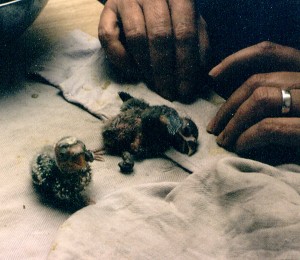
Fuzzy and Precious
Not long after that, Leira started laying eggs, and soon two of them hatched. One had a fuzzy white head, so it was named “Fuzzy.” The other was obviously a very colorful bird, including a blue beak, and was dubbed “Precious.” We were very excited at the thought of having two more birds as lovable as Ariel, but they only lived for a few weeks, and were lovingly laid to rest under a cedar tree in the corner of the yard.
Having baby lovebirds in the house was a stressful ordeal that we didn’t want to live thru again. We talked to a friend who’s more experienced with lovebirds than we are to ask, “How do we enforce birdy birth control?” “Just take the eggs away.” Well, duh!
That may have been a mistake. After we started taking the eggs away, Leira stopped laying them and died of an impacted egg. We made a little box of folded Sunday comics (her favorite paper to chew on), laid her in it, and gave Ariel a chance to say goodbye. As we buried her next to her babies under the cedar tree, we heard the sound of Ariel grieving, which made us grieve more.
T-Lynn

Ariel and T-Lynn, on top of the world
Ariel was widowed for only a few months before he was introduced to T-Lynn. She had spent most of her life in a pet shop before she was “adopted” by an in-law. Ariel was just getting used to being single, and was kind of annoyed with having to share his cage again. T-Lynn was a grrrrrl bird, and had no interest in romance or settling down. Eventually they learned to tolerate each other and developed a marriage of convenience.
In the summertime, we like to bring the bird cage into a shady area of the garden to benefit from fresh air and conversations with other birds. One afternoon, Obbie went to move the cage to keep up with the moving afternoon shadows, but the stand was left on shaky footing and the cage fell over.
The cage broke open and both birds flew into the neighbor’s maple tree. T-Lynn was saying (in bird), “Hey Ariel, let’s go!” Ariel hesitated, and flew back to the door of the back porch. Unable to get into the house, he flew to Obbie’s shoulder in the garden. Obbie brought Ariel into the living room, then went back out to deal with the cage.
We thought T-Lynn would eventually get hungry and come back, but in spite of the food we left for her, she stayed away. We heard her in the neighborhood tree tops – a bit further away each time – for two or three days. She had been a captive all of her life, so she apparently preferred a brief life of freedom to a longer life of captivity. Ariel preferred the company of humans, who he went to for support in a time of panic.
Life with Ariel
After the stand fell over in the yard, we found a solid patio chair in which Ariel’s cage happened to fit perfectly. He liked hanging out in the yard, because it gave him a chance to chat with the neighborhood birds. We share our garden with many cardinals, robins, and mourning doves, and Ariel’s response would seem to adapt to the bird that was calling.
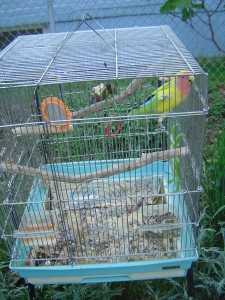
With his cage in a metal patio chair, Ariel could hang out anywhere in the yard, even in the garden.
We like to think that birds are part of a vast communication network, and that when we were on the road we would encounter “messengers” sent by Ariel. At Niagra Falls, a sparrow landed in front of us and endlessly chirped and chattered to us excitedly. We made probing eye contact with many strange birds in strange places. If we saw vultures, we figured Ariel was depressed. He also seemed to send too many crows.
There is a good cat-proof chain-link fence around the perimeter of our back yard, but there was one neighborhood cat who was not deterred by our fence. Having sternly chased him out of the yard a couple of times already, Obbie looked into the yard one day to see this cat sitting on top of Ariel’s cage. Ariel sat very still in the center of his cage, unharmed. A friendly chat with the neighbors ended our problems with this cat.
As the years passed, our lives fell into a rhythm. Ariel’s “home” stayed in the living room in the winter. When the early spring sun got warm enough, he’d spend a few afternoon hours in a south-facing window on the porch. His porch hours would get longer until he got to sit in the yard. For part of the summer, he’d spend his nights on the porch until fall came and the cycle reversed itself.
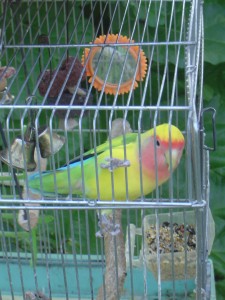
Ariel in his cage on a summer afternoon.
For his part, Ariel became attuned to OUR daily rhythms. We had an afternoon routine that began when Obbie comes home from work, and one step of this routine was to let Ariel “out” until dinnertime. He learned to recognize the part of our afternoon routine which meant that it was time for him to get out, so he would screech, ring his bells, and rattle his cage to remind us.
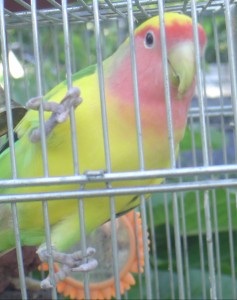
It’s TIME!
He got this social time with us twice each day, usually loitering on one of our shoulders. He liked to hang out on our knees and cuddle up to the warmth of the laptop when it was there. Other favorite pastimes were turning paper into jagged quarter-inch strips and throwing pencils off the coffee table.
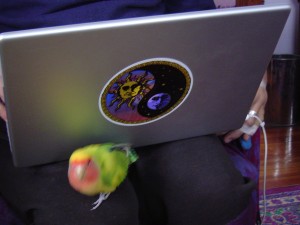
Ariel cuddles up to the laptop.
If he got bored in the living room, he’d fly into the kitchen to check out the action there. If there were prospective toys on the table, he’d try throwing them. If water was running in the sink, he would butt in for a drink or to rinse his head.
Ariel would aggressively attack any rice, millet or sweet corn that appeared in his presence… but then he could be pacified with his own personal stash of such food. He also had a thing for fresh carrots, apples, kohlrabis, and many other fresh foods. A fresh clean organic carrot was often enough to lure him to his cage for the night.
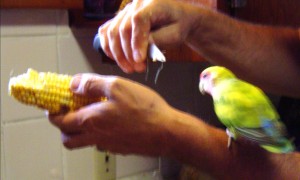
In the middle of corn processing, Ariel tries to get a little too close to the action.
Ariel had a multitude of mostly affectionate names which we would choose from to suit our moods. The Czech word for “bird” is “ptak”, which sounds like a Klingon insult. So we enjoyed speaking in Czech when we called him Bird, Boid, goofy bird, goofy little bird, silly little bird, little s#!t, or BAD little bird. He’s also been lovingly addressed as PITA (Pain In The A$$), Little Whinge-feather, Mr. Belldinger, and Sir Squawksalot.
The End
A lovebird web site had a memorable passage on life expectancy. It’s comparable to that of a dog – 14 years or so, but “with the right food and exercise, you could have your bird for a LONG time.” It went on to tell tales of 30-year-old lovebirds.
We began to wonder if we were destined to tell one of these tales. The weird thing about lovebirds is that there are no obvious signs that they’re getting old. Their feathers don’t turn grey. They don’t start squawking in an old and raspy voice. By 2009, Ariel was at least 15 and even though he was as strong and active as ever, he was showing signs of becoming old and ornery.
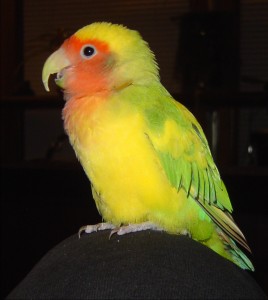
Ariel in his last photo session (January 2009), as he was growing old and long in the beak.
We used to joke about him getting “old and long in the beak.” Where his beak used to naturally stay at a certain reasonable length, it began to grow so long that it nearly stabbed him in the chest. He had difficulty eating, yet he resisted with all of his might to our efforts to trim his beak. Every couple of months, RoZ would trim it, which would be followed by two days of shunning RoZ and eating.
There were more signs that we had a geezer bird. He was no longer interested in humping our toes. He grunted and made beak-grinding noises that sounded like an old guy. He went to bed early: every night at exactly 9:30 he would ring his bells and rattle his cage, demanding to be covered for the night.
Another thing we read in the bird books was that old birds don’t fade away… they drop dead suddenly. That seems to be what happened to Ariel. Our big regret is that we weren’t at home with him when he left us. In late May, while we were in Minnesota celebrating a wedding, our birdsitter found him lifeless on the bottom of his cage.
We wrapped him in a nice towel and then laid him into an old wooden cigar box. A hanging lava rock and bell that he had most of his life was included with some of his favorite toys. RoZ glued some beautiful dried flowers to the top of the box, and we buried him next to his wife and kids: Leira, Precious and Fuzzy.
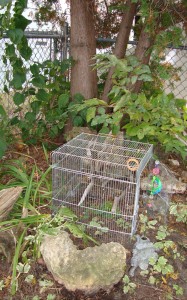
Ariel’s final home in a corner of the garden.
The top part of his cage sits over his grave with the door propped open. Photos of Ariel look in on us from the desktop of the living room computer to remind us of the task at hand: to digest his life into a worthy tribute.
As the summer passed, the local cardinals and robins would stand watch on the railings outside the back porch window, looking for Ariel in his usual spot on the porch. They missed him, too.
We announced the end of Ariel’s time in this world via an email to most of our friends and family, and during the immediate aftermath some well-intentioned friends would ask if we planned to get another bird. The question seems silly to us. The personality of a unique being like Ariel cannot be replaced. We could get another bird, but it wouldn’t be Ariel. If and when the time is right to allow another creature into our lives, that creature will introduce itself to us.
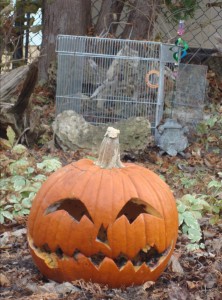
Ariel’s corner of the garden in late fall.
Life is different without Ariel. He still haunts the timing of our day: When we finish our morning coffee and newspaper, we still feel the impulse to let Ariel out. We don’t have the rattling of bells waking us up when we’re trying to sleep in on weekends. We’re easily adjusting to the lack of feathers, seeds, and little white calling cards to clean up. It’s safe to leave papers, pencils, and photographs lying around.
But when we’re not together… when one of us is home alone… the house is a much more lonely place. Ariel was part of our lives for twelve years, so we miss him dearly and it will take a long time to adjust to his absence.
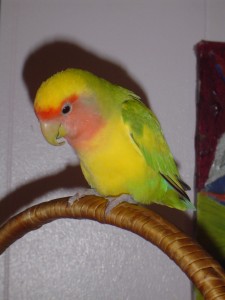
Ariel in 2008.
Special bonus video….


That’s a great story you guys, very cool that you spent the time putting it together. You really ought to send it to Bird Talk magazine, they often print these kinds of stories..
I had forgotten that you guys ended up with Ubu, he was probably the hardest bird for me to pass on, he had such a big personality for such a small bird.
Also I’m pretty sure Ariel was older than 15, since he was an adult when Troy got him which I believe was in 91.
A beautiful tribute to Ariel. I remember being quite surprised while watching him quickly and neatlytrim the edges of some of the pages of one of your collectors books. (of course moving quickly to distract him from his task when I realized you might not be happy about it. I hold Ariel in my heart, and as I write this I am looking at one of his beautifu tailfeathers which I keep on a geode on my desk at work. Ariel tolerated my attempts to bird-sit him, knowing and understanding that I did not fully understand all that he would have liked me to do while I was with him. He is a beautiful spirit.
wow,i want to be your bird in my next life. really miss you guys. happy valentines to you two love bugs. oh im working for a recording studio, rosie call me lets talk. PEACE,jill
Thanks to all who commented, and there are probably many more comments to come. Here are some responses we received thru our personal email…
“Touching. Very interesting reading. Made me laugh numerous times. Ariel was quite the bird. I had no idea that they had such personality. Makes me sad that I did not meet the old geezer. I know the pain. We lost [our dog] who was a character himself.”
“…We sat here earlier and watched all the video clips of, Ariel and laughed at his silliness. [Our young son] really got a kick out of him. It was a lovely tribute, which I enjoyed reading and revisiting the wonder that was the lovely Ariel.”
“Thanks for sharing. We’ve had a couple of birds over the years, not nearly as special as Ariel it would appear.
You were quite blessed.”
“Loved your tribute to Ariel. Wonderful and very touching. He was so lucky to find the two of you and you him.”
@mIEKAL:
We’d lived on the assumption that Ariel was born in about ’90 until YOU told us you thought it was ’93.
Now we’re confused.
🙂
Either way, he definitely lived to be a geezer-bird.
I’m so sorry to hear of ariel’s passing! Thanks for your article.
What a kind tribute. It brought me to tears. I lost my beloved cat Ralf 4 years ago this month. He lived with us for 19 years. There is no replacing them. My 15 year old Maggie May is starting to decline. I will take videos of her. I love how you were able to capture the energy of your sweet friend Ariel. Thank you for sharing this.